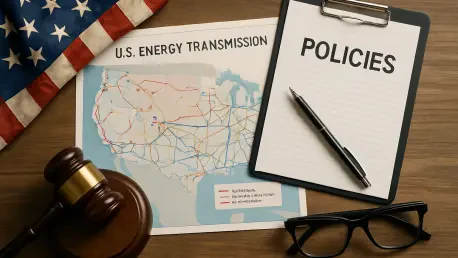I’m thrilled to sit down with Christopher Hailstone, a seasoned expert in energy management and renewable energy, with a deep understanding of electricity delivery and grid reliability. As our go-to utilities specialist, Christopher has a wealth of insights on how policy and infrastructure intersect to shape the future of energy in the United States. Today, we’ll dive into the pressing challenges facing the energy sector, the intricacies of transmission infrastructure development, and the ongoing debate over policies that could either speed up or slow down critical projects during what has been declared a national energy emergency. Our conversation will explore the balance between cost, speed, and reliability in building the grid of tomorrow.
Can you start by shedding light on what it means to declare a ‘national energy emergency’ and why this has become a focal point in recent policy discussions?
Absolutely, Silvia. Declaring a national energy emergency signals that the current state of our energy systems is not just a challenge but a critical issue requiring urgent action. It’s a recognition that without immediate and substantial investment, we risk failing to meet growing demand—whether that’s from new industries like data centers or simply keeping the lights on for existing customers. This declaration underscores a reality where our infrastructure is stretched thin, unable to keep pace with technological and economic shifts. It’s a call to prioritize speed and scalability in addressing these gaps, especially in how we deliver power across the country.
What are some of the biggest infrastructure hurdles limiting energy production right now, and how do they impact emerging sectors?
The core issue is that our transmission infrastructure—those high-voltage lines that carry electricity over long distances—is outdated and insufficient for current needs. We’re not just talking about aging equipment but also a lack of new lines to connect renewable energy sources or power-hungry sectors like manufacturing and data centers. These industries are expanding rapidly, and without the grid capacity to support them, they face delays or even relocation to other countries. It’s a bottleneck that stifles innovation and economic growth, making infrastructure not just a technical problem but a strategic one for national competitiveness.
Let’s talk about a key policy from the past decade—Order No. 1000. Can you explain its original purpose and how it reshaped the development of transmission infrastructure?
Order No. 1000, issued by the Federal Energy Regulatory Commission in 2011, was designed to shake up the traditional model of transmission development. Historically, local utilities had the first shot at building infrastructure in their areas, but this order opened up a competitive bidding process to third-party developers. The goal was to drive down costs through competition and encourage innovation in how projects were planned and executed. It fundamentally changed the game by prioritizing cost efficiency over local control, aiming to ensure that the best and cheapest proposals would win out, regardless of who submitted them.
Looking back, do you think Order No. 1000 has lived up to its promise of delivering cost savings and better outcomes for transmission projects?
Honestly, the results are mixed at best. While the intent was to save money through competitive bidding, the data over the past decade shows that cost savings haven’t been as significant as hoped. In many cases, the difference between bids from local utilities and third-party developers isn’t substantial. More critically, the bidding process has often slowed things down—adding months or even years to project timelines due to solicitation and evaluation phases. When you factor in delays, the indirect costs can outweigh any upfront savings, leaving us questioning whether the policy truly serves the urgent needs we face today.
A term that comes up a lot in this context is ‘rights of first refusal,’ or ROFR. Can you break down what this means for local utilities and why it’s seen as a potential solution?
Rights of first refusal, or ROFR, refer to a policy where local utilities get the first opportunity to develop transmission projects in their service areas before outside developers can bid. The argument for reinstating ROFR is that it cuts through the red tape of lengthy bidding processes, allowing projects to start sooner. Local utilities are already embedded in the region—they know the grid, the community, and the regulatory landscape. By giving them priority, you’re leveraging their readiness to act quickly, which is crucial in an energy emergency where every month of delay can cost millions in lost opportunities or higher consumer prices.
There’s concern from some quarters that ROFR could lead to higher costs for consumers. How do you address this worry, and does the data support it?
It’s a valid concern, and groups like the Department of Justice have raised the point that limiting competition might reduce pressure on utilities to keep costs down. However, when you look at the data from the last decade, the cost differences between ROFR projects and competitively bid ones aren’t as stark as critics suggest. What’s often overlooked is the cost of time—delays from bidding can lead to inflation, supply chain issues, or missed economic benefits, which ultimately hit consumers harder than a slightly higher bid might. Speed can be a form of savings, and ROFR prioritizes that balance.
One advantage often cited for local utilities is their deep understanding of regional needs. Can you elaborate on how this local expertise plays a role in successful transmission projects?
Local utilities have a unique edge because they’re not just building infrastructure—they’re part of the community. They understand the specific demands of their service area, from weather patterns to peak usage times, and they have established relationships with regulators and landowners. This familiarity leads to more realistic project plans and fewer surprises during construction. For instance, they’re less likely to underestimate costs or timelines compared to an outside developer who might not grasp local nuances. I’ve seen cases where local utilities have navigated complex permitting issues faster simply because they’ve built trust with stakeholders over years.
Delays in building transmission lines are clearly a major barrier, especially for renewable energy projects. How do these delays ripple out to affect the broader energy landscape?
Delays in transmission development create a domino effect. Take renewable energy—wind and solar projects often sit idle in interconnection queues, waiting for lines to be built so they can deliver power to the grid. This not only stalls clean energy goals but also discourages investment. Companies looking to expand in the U.S. might reconsider if they can’t get reliable power on time, potentially taking their business elsewhere. On a regional level, these delays mean higher electricity costs as supply struggles to meet demand. It’s a hidden economic drag that affects everything from consumer bills to national security.
What is your forecast for the future of transmission policy, especially given the current urgency of the energy emergency?
I think we’re at a turning point where policymakers will need to prioritize speed and certainty over theoretical cost savings. The energy emergency isn’t just a buzzword—it’s a real constraint on our economy and security. I expect we’ll see a push toward policies like ROFR to accelerate transmission buildouts, paired with reforms to streamline permitting. At the same time, there’s likely to be continued debate over how to balance local control with competition. My forecast is that within the next few years, we’ll see a hybrid approach emerge—one that leverages local expertise for urgent projects while still encouraging innovation from outside players. But the clock is ticking, and the decisions made now will shape our grid for decades.









